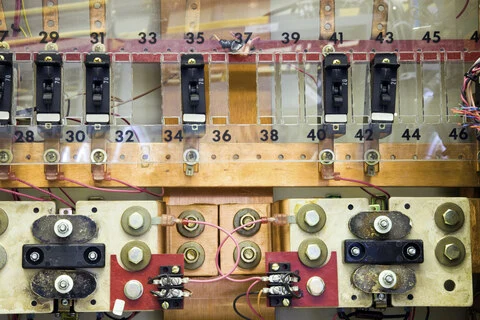EMC (Electromagnetic Compatibility)

Whether you work with hydro, wind, thermal, or alternative power generation; power generators; low voltage or high voltage distribution; power distribution racks or cables; smart grid or ensuring workplace safety, the power industry has a strong focus on standardization and interoperability. This list on EMC (Electromagnetic Compatibility) includes standards from ISO and others.
IEC 61000-2-4 Ed. 2.0 b:2002
Electromagnetic compatibility (EMC) - Part 2-4: Environment - Compatibility levels in industrial plants for low-frequency conducted disturbances
This part of IEC 61000 is concerned with conducted disturbances in the frequency range from 0 kHz to 9 kHz. It gives numerical compatibility levels for industrial and non-public power distribution systems at nominal voltages up to 35 kV and a nominal frequency of 50 Hz or 60 Hz. Compatibility levels are specified for electromagnetic disturbances of the types which can be expected at any in-plant point of coupling within industrial plants or other non-public networks, for guidance in a) limits to be set for disturbance emission into industrial power supply systems; b) the choice of immunity levels for the equipment within these systems.
IEC 61000-6-1 Ed. 3.0 b:2016
Electromagnetic compatibility (EMC) - Part 6-1: Generic standards - Immunity standard for residential, commercial and light-industrial environments
IEC 61000-6-1:2016 for EMC immunity requirements applies to electrical and electronic equipment intended for use in residential, commercial, public and light-industrial locations. Immunity requirements in the frequency range 0 Hz to 400 GHz are covered. No tests need to be performed at frequencies where no requirements are specified. This generic EMC immunity standard is applicable if no relevant dedicated product or product-family EMC immunity standard exists. This third edition cancels and replaces the second edition published in 2005. This edition constitutes a technical revision.
IEC 61000-6-3 Ed. 2.1 b:2011
"Electromagnetic compatibility (EMC) - Part 6-3: Generic standards - Emission standard for residential, commercial and light-industrial environments"
"IEC 61000-6-3:2006+A1:2010 This part of IEC 61000 for EMC emission requirements applies to electrical and electronic apparatus intended for use in residential, commercial and light-industrial environments. Emission requirements in the frequency range 0 Hz to 400 GHz are covered. No measurement needs to be performed at frequencies where no requirement is specified. This generic EMC emission standard is applicable if no relevant dedicated product or product-family EMC emission standard exists. This standard applies to apparatus intended to be directly connected to a low-voltage public mains network or connected to a dedicated DC source, which is intended to interface between the apparatus and the low-voltage public mains network. This standard applies also to apparatus which is battery operated or is powered by a non-public, but non-industrial, low-voltage power distribution system if this apparatus is intended to be used in the locations described below. The environments encompassed by this standard are residential, commercial and light-industrial locations, both indoor and outdoor. The following list, although not comprehensive, gives an indication of locations that are included: - residential properties, for example houses, apartments; - retail outlets, for example shops, supermarkets; - business premises, for example offices, banks; - areas of public entertainment, for example cinemas, public bars, dance halls; - outdoor locations, for example petrol stations, car parks, amusement and sports centres; - light-industrial locations, for example workshops, laboratories, service centres. Locations that are characterised by being supplied directly at low voltage from the public mains network are considered to be residential, commercial or light-industrial. The object of this standard is to define the emission test requirements for apparatus defined in the scope in relation to continuous and transient, conducted and radiated disturbances. The emission requirements have been selected so as to ensure that disturbances generated by apparatus operating normally in residential, commercial and light-industrial locations do not exceed a level which could prevent other apparatus from operating as intended. Fault conditions of apparatus are not taken into account. Not all disturbance phenomena have been included for testing purposes in this standard but only those considered as relevant for the equipment covered by this standard. These requirements represent essential electromagnetic compatibility emission requirements. Requirements are specified for each port considered. This consolidated version consists of the second edition (2006) and its amendment 1 (2010). Therefore, no need to order amendment in addition to this publication. "
IEC 61000-6-6 Ed. 1.0 b:2003
Electromagnetic compatibility (EMC) - Part 6-6: Generic standards - HEMP immunity for indoor equipment
This part of IEC 61000 sets high-altitude electromagnetic pulse (HEMP) immunity requirements for electrical and electronic equipment intended for use indoors. The indoor HEMP environment depends on the electromagnetic shielding quality of a facility and the level of protection against the conducted environment. This standard is intended for all facility types including residential, commercial, light industrial, hospitals, heavy industrial, power substations and power generation facilities. This standard includes indoor equipment intended to be connected to a low-voltage (1 kV or less) power network, to the telecom network and/or to external antennas. Immunity test values are based on the 90 % severity levels in IEC 61000-4-25. All telecom lines are assumed to have gas-tube protectors at the point where they enter the building and insulation flashover on low-voltage lines are assumed at three times that of lightning. For signal ports connected to internal cables, severity test levels are based on cables that have a total length of 10 m and a procedure is provided for longer cables. This part of IEC 61000 does not specify safety requirements for equipment, such as protection against shock, insulation coordination, and related dielectric tests. Nevertheless, the immunity tests described in this part of IEC 61000 involve hazardous voltages. High-voltage precautions are necessary to protect the health and safety of test personnel.





